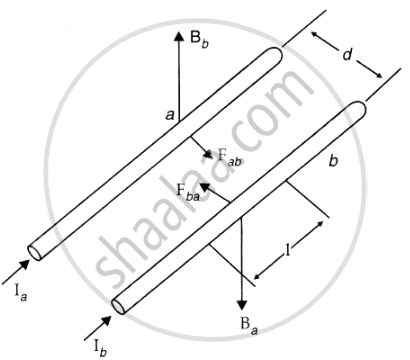Advertisements
Advertisements
Question
Two long straight parallel conductors carrying currents I1 and I2 are separated by a distance d. If the currents are flowing in the same direction, show how the magnetic field produced by one exerts an attractive force on the other. Obtain the expression for this force and hence define 1 ampere.
Solution
Fab = Force experienced by wire 'a' of length 'l' due to the magnetic field of wire 'b'
Fba = Force experienced by wire 'a' of length 'l' due to the magnetic field of wire 'b'
Ba = Magnetic field due to wire 'a'
Bb = Magnetic field due to wire 'b'
Ba = `(mu_0I_a)/(2rd)`
Since `vecF = i(vecl xx vecB)`
`F_(ba) = I_1. l(mu_0I_2)/(2rd)`
Similarly, `F(ab) = I_1.l(mu_0I_2)/(2rd)`

The direction of force experienced by wire 'a' is toward wire 'b'. (As shown in the diagram).
Similarly, the direction of force experienced by wire 'b' is toward wire 'a'. Thus, the force is attractive.
If two long wires are placed in a vacuum at a separation of 1 m, one Ampere would be defined as the current in each wire that would produce a force of 2 × 10–7Nm–1 per unit length of wire.
APPEARS IN
RELATED QUESTIONS
Using the concept of force between two infinitely long parallel current carrying conductors, define one ampere of current.
What is the magnitude of magnetic force per unit length on a wire carrying a current of 8 A and making an angle of 30° with the direction of a uniform magnetic field of 0.15 T?
A charged particle goes undeflected in a region containing an electric and a magnetic field. It is possible that
(a) `vecE" || "vecB , vecv" || " vec E `
(b) `vecE "is not parallel" vecB`
(c) `vecv " || " vecB but vecv "is not parallel"`
(d) `vecE" || " vecB but vecv "is not parallel"`
An electron is moving along the positive x-axis. You want to apply a magnetic field for a short time so that the electron may reverse its direction and move parallel to the negative x-axis. This can be done by applying the magnetic field along
(a) y-axis
(b) z-axis
(c) y-axis only
(d) z-axis only
A straight wire of length l can slide on two parallel plastic rails kept in a horizontal plane with a separation d. The coefficient of friction between the wire and the rails is µ. If the wire carries a current i, what minimum magnetic field should exist in the space in order to slide the wire on the rails?
A rectangular coil of 100 turns has length 5 cm and width 4 cm. It is placed with its plane parallel to a uniform magnetic field and a current of 2 A is sent through the coil. Find the magnitude of the magnetic field B if the torque acting on the coil is 0.2 N m−1
Three coplanar parallel wires, each carrying a current of 10 A along the same direction, are placed with a separation 5.0 cm between the consecutive ones. Find the magnitude of the magnetic force per unit length acting on the wires.
A milli voltmeter of 25 milli volt range is to be converted into an ammeter of 25 ampere range. The value (in ohm) of necessary shunt will be ______.
Beams of electrons and protons move parallel to each other in the same direction. They ______.
